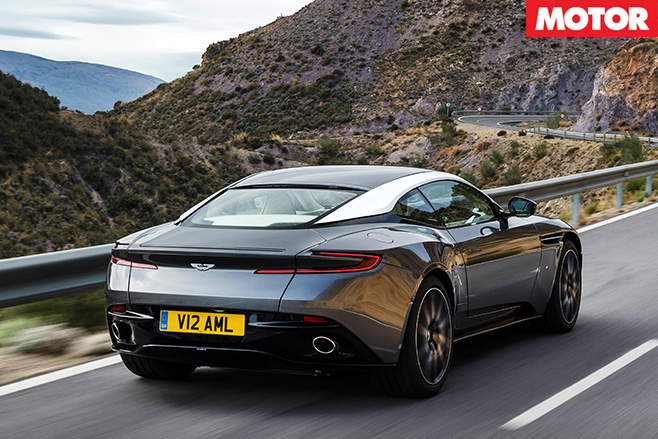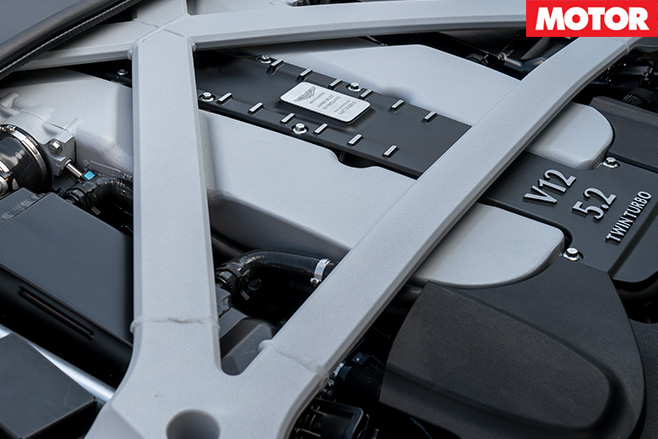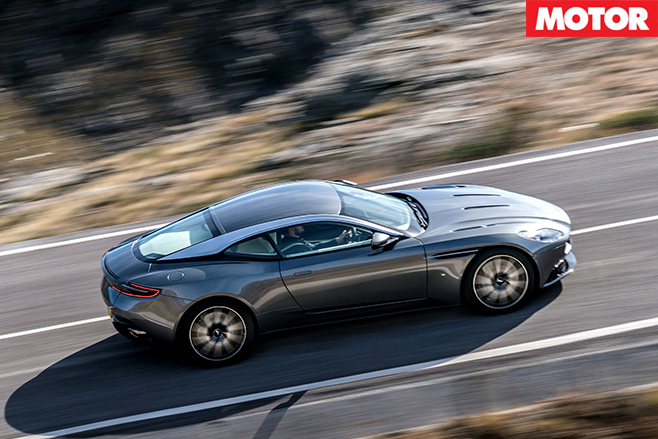With 447kW and 700Nm from a 5.2-litre twin-turbocharged V12 engine, the Aston Martin DB11 arrives claiming a 3.9-second 0-100km/h.
For its first full-size coupe in thirteen years, the DB9 replacement matches the time to the ton of the Porsche 911 Carrera S and comes within a tenth of the Mercedes-AMG GT it will be priced just above. It is seven-tenths faster than the 5.9-litre naturally aspirated V12 it replaces.
Bonded aluminium construction for the new body includes a clamshell bonnet, roof and doors made of pressed aluminium, rear haunches, front wings and rear spoiler constructed of composite material; plus bumpers, sills, front splitter and rear diffuser engineered from injection-molded plastic.

No less than eight heavily contoured bonnet lines slice from front windscreen to front bumper, from fender to fender, a contrast to both the smoother DB9 and the rounded headlight and grille shape of the DB11.
Above the beefy rear haunches is a noticeable black character crease underscoring the rear window line and sweeping silver roof pillar. The C-shaped LED rear tail-lights encircle a rear decklid that is more concave and angular than before.
Compared with its predecessor the exclusively rear-wheel drive DB11 boasts a 65mm wheelbase increase over a 50mm-longer body. Front overhang slips down by 16mm, with the V12 now pushed further behind the front axle line, while rear overhang increases by 11mm. Width increases by just 28mm, though the tracks swell by 75mm front/43mm rear.

A cockpit focused on a slim, upright centre stack includes an 8.0-inch colour TFT display connected to a Mercedes-Benz-derived infotainment system – even the controller is shared with C-Class and others. A 12.0-inch TFT also sits in front of the driver.
Of its new in-house-designed engine, Aston Martin claims it “is not just a collection of impressive numbers … it also has impressive character thanks to its tremendous breadth of performance, exceptional response and authentic V12 soundtrack.”

The DB11 boasts “a magnificently right and potent soundtrack that can switch from mellow to malevolent with a squeeze of the throttle.”
The DB11 also features sound adjustments made via a three-mode driving selector, however, with GT, Sport and Sport+ modes increasingly making the exhaust, in addition to the transmission and engine response, suspension and new electro-mechanical steering set-up more aggressive.

Adjustable suspension by Bilstein means that GT mode provides “exemplary ride quality and maturity of character”; selecting Sport mode “adds a touch more firmness, control and response to the damping” and choosing Sport+ “truly awaken the sports car within.”
The DB11 rolls on 255mm 45-aspect front/295mm 35-aspect rear 20-inch Bridgestone S007 tyres with six-piston 400mm front/four-piston 380mm rear brakes behind them. Aerodynamic performance is said to be a focus of the DB11 program.

Sales of the Aston Martin DB11 will begin during the fourth quarter of 2016 and it will ask £154,900 in the UK, €204,900 in Germany and $211,995 in the US. Expect a 2017 launch in Australia with a circa-$350k sticker price locally.





